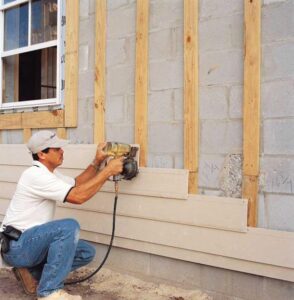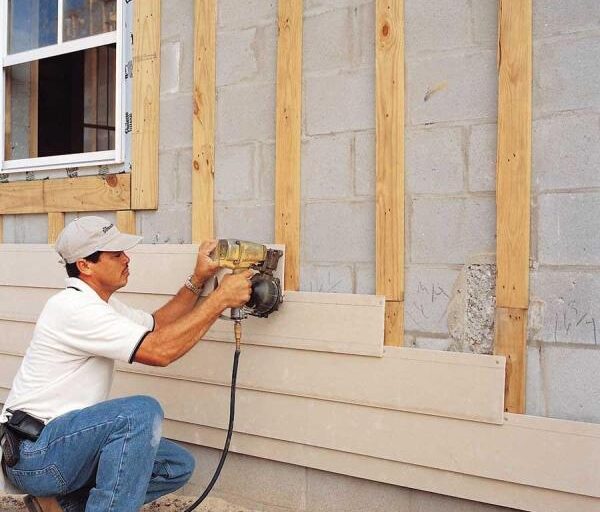Choosing the right siding for your new home is a big decision like Stucco Charleston SC. It can have a long-lasting impact on your home’s look and value.
One product that is growing in popularity among homeowners is fiber cement siding. Read on to learn about the benefits of this powerful material. You’ll also discover some things to consider before making your final choice.

The durability of cement siding makes it a great choice for homeowners who want to protect their investment. It can withstand harsh weather conditions, including heavy rains and snow. It is also resistant to rot, warping, and pests. Its solidity also protects against debris, hail, and other damaging elements. Fiber cement siding is also available in various color options, giving homeowners the flexibility to achieve their desired aesthetic.
Cement siding is formed through autoclaving, which uses extreme steaming to bond materials such as sand and cellulose. This process gives it one of the highest resistance and durability ratings of all siding materials. This robust material can withstand high winds and large hail damage, which can crack windows, shingles, and other roof components. It is also resistant to rot, mold, and mildew due to its moisture resistance. Unlike wood, it is not susceptible to the growth of insect infestations.
In addition to its strength, durability, and longevity, cement siding is easy to maintain and clean. It can be sprayed with a garden hose or scrubbed with a mild detergent and nylon brush to remove dirt and grime. It is also water-resistant, making it an ideal choice for homes near bodies of water. Unlike vinyl siding, it does not need to be painted regularly, as the factory paint can last up to 25 years.
Whether you want to upgrade your existing home or build a new house, a durable exterior siding option is essential. Many homeowners are turning to fiber cement siding, which offers an unmatched combination of beauty and protection. The durability of this material ensures that your home will stand the test of time, while its beautiful design will enhance its curb appeal.
James Hardie fiber cement siding is popular among homeowners searching for a long-lasting, low-maintenance exterior solution. The quality and versatility of this product make it an excellent choice for all types of homes. It is available in various colors and textures, allowing homeowners to choose a finish that fits their unique style. It is also fire-resistant and can help lower homeowner’s insurance costs.
Fiber cement siding offers a style that is both attractive and durable. It can be fashioned into an array of textures that mimic traditional wood siding, and it is available in clapboard and shingle styles to suit your home’s architectural style. It can also be matched with trim made from the same material to ensure a consistent look for your home.
Traditional wood-based siding has the benefit of a natural appearance that many homeowners enjoy. However, it requires frequent staining or refinishing to keep its colors vibrant. Additionally, wood often rots and must be replaced over time, making it expensive. For these reasons, some homeowners choose fiber cement siding as an affordable alternative to wood.
Cement siding is available in planks that resemble vinyl, smooth textures that mimic real wood, and stucco finishes to give your home a modern aesthetic. The surface of the siding is important, as it will determine how the panels overlap each other and will affect your home’s overall appearance. For example, if you want your siding to look like stacked stones, builders will stand long panels on the end and use narrow battens to cover vertical seams and horizontal field lines.
Hardie board, one of the leading brands of cement cladding, comes in several sizes and finishes to create a look that matches your home’s exterior. Its color options are among the most vibrant on the market, and a 25-year warranty backs it. The company also produces soffits, fascia boards, and crown moldings to match your new cement siding for a complete renovation.
Another leading brand of fiber cement siding is Nichiha, which boasts a wide range of textures and color options for its products. Its clapboards are available in authentic looks of stone, brick, concrete, and stucco, while its smooth fiber cement boards come in an impressive assortment of hues that include some of the most authentic shades on the market.
Regardless of the type of cement siding you choose, your contractor should ensure that all gaps are caulked, and any joints are joined with rust-proof stainless steel screws. They should also use a caulking compound that is waterproof and UV-resistant to ensure your siding will be weatherproof and protect your home for the long term.
Regarding home cladding, wood, brick, vinyl, and stucco often steal the spotlight, but fiber cement siding is quickly becoming one of the most popular options for homeowners. The durable material benefits homeowners and can complement traditional or modern exterior home designs. It is highly resistant to rain, hail, fire, and other environmental elements, and it can last for years with minimal maintenance.
Besides being extremely durable, cement siding is also energy efficient. While it doesn’t insulate a house as well as vinyl or wood, it does help keep cool air in during the summer and warm air in winter, which helps reduce energy costs. When paired with additional insulation, such as James Hardie’s Fanfold insulation panels, the product can boost your home’s U-value and R-value, increasing its energy efficiency and helping you save money on your heating and cooling bills.
The durability and insulating properties of cement siding make it a smart choice for many homeowners, especially those living in cold, damp climates. It is also an eco-friendly option, as it’s a wood alternative that uses recycled materials and doesn’t require tree harvesting. Moreover, it doesn’t release toxic chemicals like vinyl does during production.
In addition, because it can withstand a high moisture level, mold and mildew are less likely to appear on your home’s façade. If they occur, they can easily be removed with a soft brush or a hose spray. Furthermore, the material is fireproof and won’t be affected by a direct flame or extreme heat. Some insurance companies offer discounts to homeowners who choose fiber cement siding because it helps prevent costly repairs due to fire damage.
While cement siding has much to offer homeowners, it’s important to look for a manufacturer with a solid reputation and a transferable warranty if you decide to sell your home. Additionally, when selecting the color of your new siding, consider the architectural style of your house and surrounding landscaping to ensure it fits in perfectly.
The popularity of fiber cement siding — often called Hardie board — is due to its durability and relatively low maintenance requirements. It is a heavy-duty material that resists the elements and other hazards like insects, fire, and damage caused by road salt and fading from the sun. Fiber cement siding typically carries warranties of 30 to 50 years.
The composition of fiber cement siding varies from manufacturer to manufacturer, but most include Portland cement, sand, and wood fibers. The wood fibers prevent cracking and help the material withstand moisture, and a special curing process leaves the product with minimal water content. This low moisture content is one of the factors that allows the material to hold up well to harsh weather conditions and other hazards.
Cement siding is also resistant to rotting, fungus, and termites. However, it is susceptible to impact damage and may deteriorate in high-humidity environments. To ensure the integrity of the material, it is important to use a high-quality foundation sealant on all penetrations and in the caulking areas around plank and trim connections and flashings.
In addition to using a good foundation sealant, homeowners should wash their siding every six to 12 months with a garden hose and soft brush or clean wash rag. This is necessary to prevent the build-up of dirt and other debris that can damage the surface. It is also a good idea to remove accumulated debris from gutters regularly.
If the material does experience any deterioration, repair it with a patching compound or acrylic mortar patch. This is available in most hardware stores. It’s also important to make sure all nails are tight and secure. Loose or damaged siding can be a breeding ground for mold and mildew, so it’s a good idea to use commercial mold/mildew remover on any areas with problems.
It is generally recommended to have fiber cement siding installed by a professional, but DIYers can often take on some of the regular maintenance. In general, the siding should be repainted every five to 15 years. When it’s time to reapply the paint, select a high-quality latex exterior paint designed for masonry and stucco surfaces.
